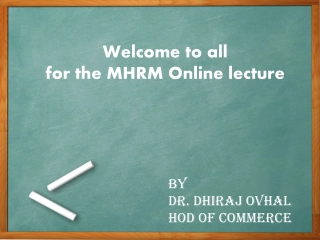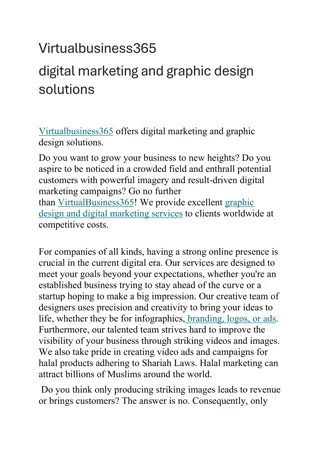MKT 420 Contemporary Issues in Marketing
Sports marketing involves creating, communicating, and delivering sports experiences that hold value for consumers and society. This chapter explores the characteristics, roles, evolution, and applications of sports marketing, emphasizing its unique features and impact on non-sport products and services.
Uploaded on Feb 20, 2025 | 1 Views
Download Presentation

Please find below an Image/Link to download the presentation.
The content on the website is provided AS IS for your information and personal use only. It may not be sold, licensed, or shared on other websites without obtaining consent from the author.If you encounter any issues during the download, it is possible that the publisher has removed the file from their server.
You are allowed to download the files provided on this website for personal or commercial use, subject to the condition that they are used lawfully. All files are the property of their respective owners.
The content on the website is provided AS IS for your information and personal use only. It may not be sold, licensed, or shared on other websites without obtaining consent from the author.
E N D
Presentation Transcript
MKT 420 Contemporary Issues in Marketing Chapter 4 Sports Marketing
Objective Describe the characteristics of sports marketing. Discuss the three roles of marketing in sports organizations. Summarize the evolution and history of sports marketing. 2
Sports Marketing Marketing is the activity, set of institutions, and processes for creating, communicating, delivering, and exchanging offerings that have value for customers, clients, partners, and society at large (AMA, 2007). Sports Marketing is the use of marketing for creating, communicating, delivering, and exchanging sports experiences that have value for customers, clients, partners, and society. 3
Features Application of general marketing practices to sport-related products and services: Sporting equipment, sport events and local clubs, team advertising, promoting an athlete, selling season tickets, licensed apparel for sale. Marketing of other consumer and industrial products or services through sport: Professional athlete endorsing a breakfast cereal, sponsorship of a sport event, beer company arranging to have exclusive rights to provide beer at a sport venue or event. 4
Dimensions 1. Marketing of Sports: Pertains to products, services, leagues, teams, venues, events, and individuals. 2. Marketing through Sports: Refers to businesses using sports as part of their marketing strategy to reach and engage their target markets. Sports sponsorship is the primary channel for marketing through sports. 5
Sport Marketing is unlike conventional marketing because it also has the ability to encourage the consumption of non-sport products and services by association . 6
Characteristics of Sports Sport is paradoxical: Professional/amateur, individual/collective, indoor/outdoor, competitive/free, Sport is a service: Intangible- Except infrastructures and accessories. Perishable (Instantaneous and non-storable)- Destroyed as soon as its produced Inseparable- Co-created by spectator/ athlete, arena/ training gymnasium Variability- All experiences aren t the same. 7
Sport is the only industrial product that can be made with: Collaborating and competing firms (teams) Often has uncertain result (result of the match) Sometimes a rigid productivity (fixed quantity of matches, of players) 8
The sport industry is a BIG business!
Organization of the Sport Industry
Sports Motivation (Consumer Behavior Aspect) Most outcome of planned purchases Some impulsive Desire to identify with sport Maslow s Hierarchy of Needs Understanding benefits desired Can be used to identify market segments 11
Maslows Hierarchy of Needs Dr. Abraham Maslow formulated a widely accepted theory of human motivation. Maslow's theory identifies five basic levels of human needs, which rank in order of importance from low- level (biogenic) needs to higher-level (psychogenic) needs. Maslow s hierarchy of needs theory suggests that individuals seek to satisfy lower-level needs before higher-level needs emerge. 12
13 Maslow s Hierarchy of Needs
Physiological Needs In the hierarchy-of-needs theory, physiological needs are the first and most basic level of human needs. Physiological needs are those things that are required to sustain biological life: food, water, air, shelter, clothing. These include biogenic needs. 14
Safety Needs After first level is satisfied, safety and security needs become the driving force behind an individual s behavior. Safety needs are concerned with much more than physical safety. Health and the availability of health care are important safety concerns. Saving account (financial reserves), medical insurance, education for a sense of security. 15
Social Needs Social needs relate to such things as need for friends, need to give and receive love, affection, belonging, and acceptance. People seek warm and satisfying human relationships with others. Because of the importance of social motives in our society, advertisers of many product categories emphasize this appeal in their advertisements. 16
Ego (Esteem) Needs These are needs to feel important. Can take an inward (internal) or outward (external) orientation, or both. Inwardly-directed ego needs reflect an individual s need for self-acceptance, for self- esteem, achievement, and for personal satisfaction with a job well done. Outwardly-directed needs relate to interaction with other people and include the needs for reputation, for status, and for recognition from others. 17
Need for Self-Actualization Need for self-actualization refers to an individual s desire to fulfill his or her potential to become everything he or she is capable of becoming. According to Maslow, most people do not satisfy their ego needs sufficiently to ever reach this level. People here tend to have needs such as truth, justice, wisdom, meaning. 18
Maslows Hierarchy and Sports Consumption Basic (Physiological) & Safety (Security): Societies where people are starving and are without shelter aren t interested in sports or staying fit. Improving health and fitness is the prime motivator for sports participation. Also not related to security needs. Social: Spectators and participants involvement in sports is motivated by a desire to confirm a sense of identity. Spectating in a sporting event bring varied people together and can affirm national unity or a sense of community. 19
Ego or Esteem: In sports research, self esteem is holding oneself in high regard. Involvement in physical activities leads to positive attitude about oneself. Achievement for sports person is in terms of success or failure; whereas for spectators it is about basking in the glory of victorious team. Self Actualization: It refers to a man s desire for self-fulfillment, and become actualized in what he is capable of. Sports provide opportunities to exceed personal expectations and express oneself. 20























